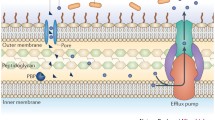Abstract
Bacterial resistance to antibiotics poses a serious challenge to the prospect of chemotherapy. Rational use of antibiotics is most desirable but it cannot provide a permanent solution to the problem. In this article the biochemical and genetic basis of antibiotic resistance in bacteria is discussed with examples. The non-clinical aspects of antibiotic-resistance are also dealt with in brief.
Similar content being viewed by others
Suggested Reading
C F Amabile-Cuevas, New antibiotics and new resistance, American Scientist, Vol.91, pp.138–149, 2003.
R I Aminov, The role of antibiotics and antibiotic resistance in nature, Environmental Microbiology, Vol.11, pp.2970–2988, 2009.
HW Boucher, GH Talbot, J S Bradley, JE Edwards, D Gilbert, LB Rice, M Scheld, B Spellberg and J Bartlett, Bad bugs, no drugs: No ESKAPE! An update from the Infectious Diseases Society of America, Clin. Infect. Dis., Vol.48, pp.1–12, 2009.
G Brackman, P Cos, L Maes, H J Nelis and T Coenye, Quorum sensing inhibitors increase the susceptibility of bacterial biofilms to antibiotics in vitro and in vivo, Antimicrob. Agents Chemother., Vol.55, pp.2655–2661, 2009.
M K Chattopadhyay and H-P Grossart, Antibiotic resistance, intractable and here’s why, British Medical Journal, Vol.341, p.c6848, 2010.
R Jayraman, Antibiotic resistance: An overview of mechanisms and a paradigm shift, Curr. Sci., Vol.96, pp.1475–1484, 2009.
P Keith, Uninhibited antibiotic target discovery via chemical genetics, Nature Biotechnol., Vol.22, pp.1528–1529, 2004.
S B Levy, The antibiotic paradox: How the miracle drugs are destroying their miracle, Plenum Press, New York, USA, 1992.
M N Alekshun and S B Levy, The escherichia coli mar locus — antibiotic resistance and more, ASM News, Vol.70, pp.451–456, 2004.
K Palaniappan and R A Holley, Use of natural antimicrobials to increase antibiotic susceptibility of drug resistant bacteria, Int. J. FoodMicrobiol., Vol.140, pp.164–168, 2010.
J L Rosner, Nonheritable resistance to chloramphenicol and other antibiotics induced by salicylates and other chemotactic repellents in Escherichia coli K-12, Proc. Natl. Acad. Sci., USA. Vol.82, pp.8771–8774, 1985.
G H Talbot, What is in the pipeline for Gram-negative pathogens? Expert Rev, Anti Infect. Ther., Vol.6, pp.39–49, 2008.
S K Vooturi and S M Firestine, Synthetic membrane-targeted antibiotics, Curr. Med. Chem., Vol.17, pp.2292–2300, 2010.
Saurabh Dhawan and Tomas J Ryan, The bacterium that got infected by a cow!, Resonance, Vol.12, No.1, pp.49–59, 2007.
H Surya Prakash Rao, Capping drugs: Development of prodrugs, Resonance, Vol.8, No.2, pp.19–27, 2003.
Avantika Lal, Quorum sensing: How bacteria talk to each other, Resonance, Vol.14, No.9, pp.866–871, 2009.
Author information
Authors and Affiliations
Corresponding author
Additional information
Saswati Sengupta is a reserach associate at the Indian Institute of Chemical Technology (CSIR). Her areas of interest are therapeutic proteins and intellectual property rights.
Madhab K Chattopadhyay is a scientist at the Centre for Cellular and Molecular Biology (CSIR). His areas of interest are stress adaptation of bacteria and antibiotic resistance in microorganisms.
Rights and permissions
About this article
Cite this article
Sengupta, S., Chattopadhyay, M.K. Antibiotic resistance of bacteria: A global challenge. Reson 17, 177–191 (2012). https://doi.org/10.1007/s12045-012-0017-8
Published:
Issue Date:
DOI: https://doi.org/10.1007/s12045-012-0017-8




